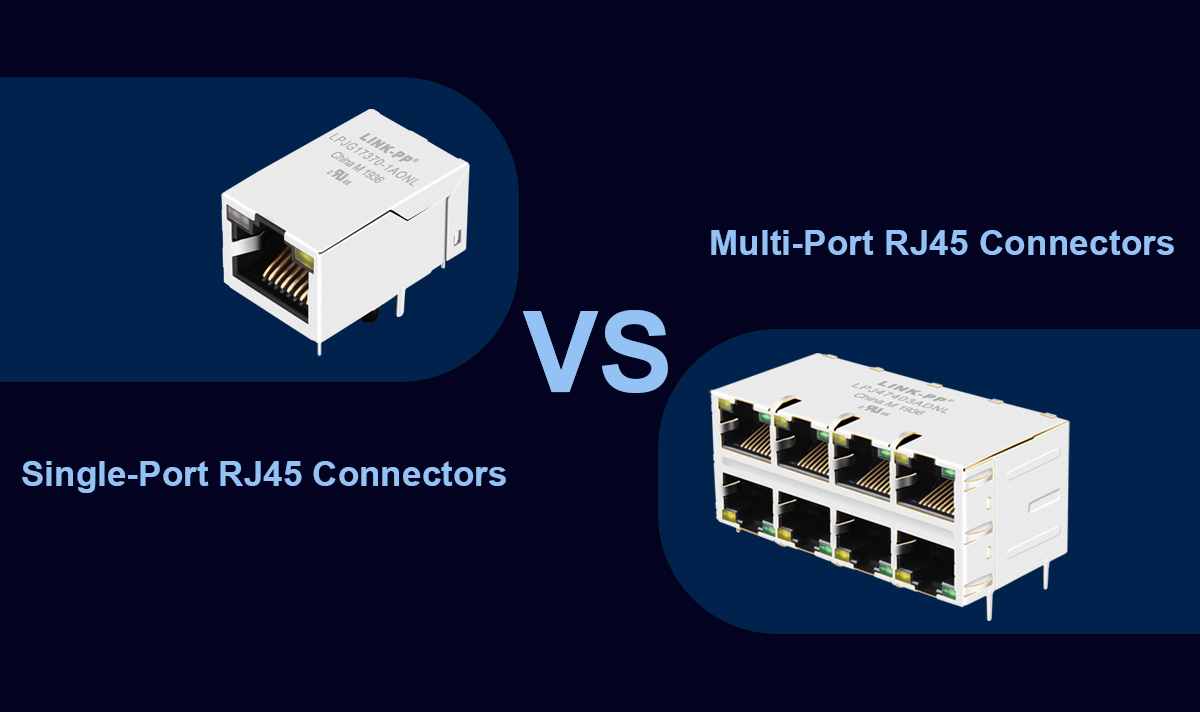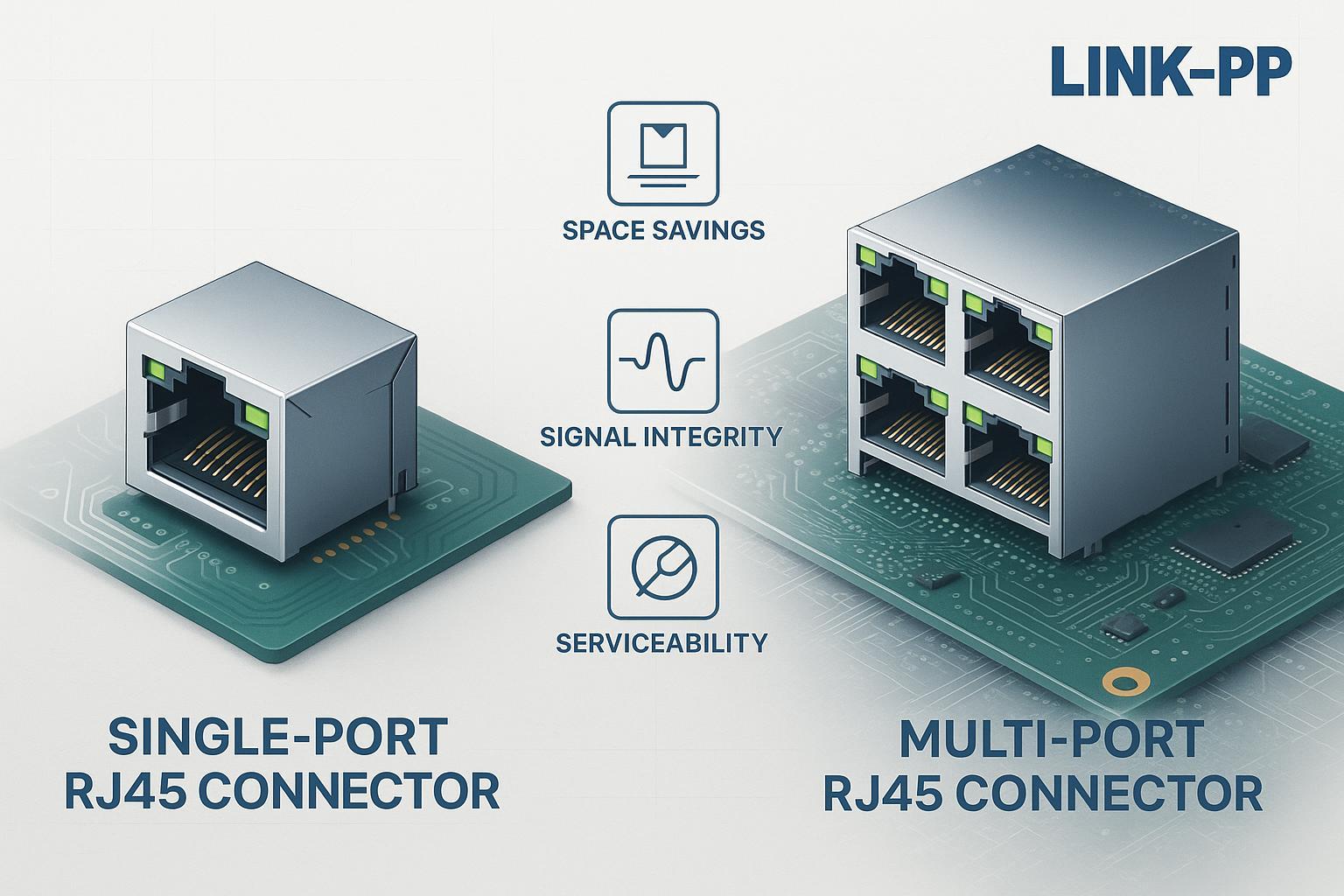
1 Form Factor & Space Utilization
Single-Port:
One connector per housing. Ideal for devices with limited port needs or isolated signal environments. Requires more PCB space for multiple Ethernet lines.Multi-Port:
Multiple RJ45 jacks grouped in one module (e.g., 1x4, 2x2, 2x8). Significantly reduces board space and enables high-density Ethernet designs.
2. Design Complexity
Single-Port:
Simpler to route, lower EMI concerns, often used in industrial or consumer devices with low Ethernet traffic.Multi-Port:
Complex internal routing. EMI shielding and crosstalk management are more critical. Ideal for switches, routers, servers.
3. LED & Magnetic Integration
Both types may include integrated magnetics, PoE support, and LED indicators. However:
Multi-Port modules often offer ganged LED or centralized magnetics for all ports.
Single-Port units allow more customization per port.
4. Assembly & Manufacturing
Multi-Port reduces pick-and-place operations and BOM count, improving manufacturing efficiency.
Single-Port may be more flexible in modular assembly or when layout needs are irregular.
5. Typical Use Cases
Application | Recommended Connector Type |
|---|---|
Industrial Devices | Single-Port |
Network Switches | Multi-Port (e.g., 2x8 or 1x6) |
Consumer Electronics | Single-Port |
Enterprise Routers | Multi-Port |
Test Equipment | Single-Port or mixed |
Application Scenarios (Deployment Flexibility)
Single-Port:
Datacenter uplinks, SAN/fail-safe controls, field/utility panels, telco edge, devices requiring extreme reliability and fast repair.
Multi-Port:
Switches/routers/servers in rackmount/campus, factory-floor and enterprise backbone, high volume or modular chassis.
Mixed strategy:
Common best practice: Use single-port for redundant uplinks/critical channels, multi-port for aggregation or user access—optimizes both serviceability and density.
6. Cost Consideration
Multi-Port modules generally offer a better cost-per-port ratio but may be more expensive as individual components.
Single-Port is cost-effective in small volume or when few ports are needed.
Scenario-Based Recommendations
Choose Single-Port When:
Critical links must be field-replaceable in under 5 minutes (e.g., telco uplink, server failover)
EMI/crosstalk pose reliability risks (industrial/process control, medical)
Deployment spans across legacy or multi-vendor boards, where certified compatibility is vital
Choose Multi-Port When:
Board space constraint trumps per-port isolation (campus/core rack gear, edge switches)
Cost-per-port and rapid volume deployment are paramount
Service access is less frequent/less critical or board-level swap is acceptable
Optimize with LINK-PP:
Leverage LINK-PP for certified compatibility, advanced PoE/surge options, special density layouts, or rapid sample-to-order turnaround at scale.
Combine single-port for uplink/critical, multi-port for aggregation: best of both worlds.
LINK-PP Solution Highlights

LINK-PP offers both single and multi-port RJ45 connectors with:
Shielded/Unshielded options
Integrated Magnetics
PoE/PoE+ compatibility
Industrial-grade reliability
LINK-PP: B2B Innovation, Compatibility, and Support
Certified cross-brand compatibility: One of the only vendors assuring fit with Pulse, Molex, Bel, Cisco, and more
Advanced PoE/surge: Up to IEEE 802.3bt; robust TVS, filter, and EMI management
Free Samples & Tech Consultation: Request free samples or engineering support on your next project
Global fulfillment: MOQ = 1, custom specs, rapid delivery, documentation support
Curious which connector truly fits your deployment? Connect with LINK-PP senior engineers for a free sample or technical consultation on your next project.
Who Should Read This?
OEM/network hardware engineers choosing RJ45 layout for new board designs.
B2B procurement and technical teams evaluating supply, reliability, and lifetime serviceability.
Data center/network architects needing to balance space, density, and critical path redundancy.
Project leads considering LINK-PP for volume deployments or custom specs.




